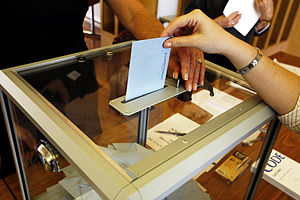John Anthony La Pietra — the Green Party of Michigan’s candidate for Secretary of State – has gone even more “public” with his leading proposals to bring Michigan fairer, better elections.
With the media generally ignoring his open letter four weeks ago and a general news release two weeks ago, John took the opportunity of a videorecorded “interview” at Detroit Public Television (DPTV) Thursday afternoon, for the MiVote.org Website, to call on his opponents to join him in paying fair shares of the fee for a statewide recount of their race.
John noted that a program of sampling audits of elections, such as has been proposed by the Michigan Election Reform Alliance (MERA), would be more cost-effective. But state law makes no provision for that yet, so a recount is the best way available to “restore people’s faith that it’s worth voting – that their votes will count . . . and be counted.”
John also renewed his invitation to voters to join in his precinct-by-precinct survey of voting conditions statewide – “so we’ll have the information we need to equip and staff polling places better, and more fairly, giving us shorter lines and more time to vote.”
John mentioned his proposals in addressing the last of four questions posed to all candidates by DPTV. The questions, reportedly drafted by MiVote sponsor the Center for Michigan, were provided to candidates ahead of time so they could prepare answers.
John’s prepared answers are posted, as part of the “Questionnaires and Answers” area of his campaign Website, at
http://members.triton.net/jalp/jalp4FBE_Q+A_DPTV+MiVote.pdf
When DPTV posts his answers on line, John will provide a link to the video from his campaign home page:
http://members.triton.net/jalp/jalp4FBE.html
Auditing Elections Could Be
Cost-Effective “Democracy Insurance”
————————————
John outlines MERA’s audit proposal in his “discussion paper” on protecting election rights.
Developed with expert input from the State Audit Working Group of the 2007 National Audit Summit, this plan calls for a central audit board independent of the elected Secretary of State’s office, which would select county audit teams to do
* manual counts of one randomly-selected race in each precinct
on election night to check for significant errors in the
performance of the tabulating equipment; and
* sampling audits soon after election day of the main statewide
races, all state Constitution ballot questions, and a
predetermined number of other randomly-selected races and
issues — feeding into the process of canvassing official
election returns — to assess and limit the statistical
risk that there has been an error affecting the result.
Auditors would not look at the election-night results before
doing their work. If an audit suggests a different winner,
election officials would be required to certify a corrected
result. And if the State Vote Audit Board can’t determine
a winner in any audited contest with what it judges is a
reasonably high level of probability, even after additional
recounts to explain or eliminate problems, a new election
would be held.
MERA’s proposal is based on maintaining a level of statistical confidence that the reported election results are accurate – so samples can be smaller when the margin is bigger. And other states that do this kind of auditing estimate the cost at about eight cents per sampled vote.
“That sounds like it could be a reasonable price for democracy insurance,” John notes. And he is offering to send an “Audit the Vote” bumper sticker free to anyone who agrees – as long as his supply lasts. Clicking on an image of the bumper sticker on the campaign homepage will open up an e-mail message to make the request.
More details of the audit proposal are available in that discussion paper at
http://members.triton.net/jalp/jalp4FBE_disc_election-rts.pdf
or on MERA’s legislative agenda page:
http://www.MichiganElectionReformAlliance.org/legis.html
Recount Proposal Includes Offer to Pay Share of
$50,000 Fee Statewide Equal to Share of Votes
———————————————
Since auditing elections is not yet part of Michigan election law, John has proposed the nearest thing to it: a full recount of the Secretary of State race. “If we want to reassure the people that election results are trustworthy, what better place to start than the race for Michigan’s Chief Elections Officer?”
John’s recount proposal calls on his fellow candidates to join him in arranging for a full recount of the Secretary of State race. And he again renews his pledge to pay his statewide vote percentage of the recount fee – $10 per precinct for over 5,000 precincts – if his rivals will do the same.
John points out that, with his self-imposed limit of taking $100 of anybody’s money, “I could be committing myself to spend more on the recount than on the rest of my campaign – if I do well . . . and if my opponents agree with me to set an example for the whole state with our race.”
The recount proposal is also in line with the Standing For Voters “Super Pledge” John has signed today:
http://www.StandingForVoters.org/index.php
Voting-Condition Survey Results Could Help Replace
Current Standard That Only Gives 2.6 Minutes to Vote
—————————————————-
John also renewed his call to voters across the state from the news release on Constitution Day to join him in finding out how equal everyone’s opportunity to vote really is in Michigan.
“Voting and election rights are critical rights, because they help protect all our other rights,” John says. “And the right to an equal voting opportunity is even more fundamental than the right to vote itself.
“But if one precinct with 1,500 voters has enough equipment, staff, and space for 20 people to vote at a time – and another precinct with just as many voters can only accommodate five voters at a time – which one’s going to have longer lines and longer waits? Where will more people get discouraged and go home without voting at all? That’s not equal voting opportunity.”
That’s why John has posted a Survey of Voting Conditions on his campaign Website, at
http://members.triton.net/jalp/jalp4FBE_voting_conditions_survey.pdf
It asks voters to look at their polling places on November 2, and see:
* How many voting stations, standing and sit-down,
the precinct has. (And how many more would fit
in the polling place.)
* How many touch-screen voting machines there are.
(This refers to the AutoMARK systems made available
mostly for voters with disabilities, though anyone
may choose to use them.)
* How many vote-counting machines (or “tabulators”)
there are.
* How many poll-workers (“election inspectors”) there
are, and whether there’s any room for more workers.
* What time they went to vote, how long they stay at
the polling place, and how long voting itself takes
them.
* How long the lines are.
The survey page also has spaces for voters to report their city or township, the number of their precinct number, their polling place (and whether or not it is shared with other precincts) – and, if they can find out from their clerk or the poll-workers, the number of voters registered in the precinct.
John also plans to ask all 83 county clerks how many voters are registered in each precinct in their counties as of Monday, October 4 – the deadline for voters to register so they can vote November 2.
“State law says the minimum requirement for a polling place is 1 voting station per 300 voters registered in the precinct. The polls open at 7am and close at 8pm. That’s 13 hours, or 780 minutes. So in a precinct with just enough equipment to be legal, the average voter has two minutes and 36 seconds to vote,” John calculates.
“That’s assuming everyone comes in to vote, of course,” he adds. “But it also assumes there’s no such thing as a peak-hour rush . . . just someone coming in the door every 2.6 minutes, like clockwork. And never spoiling a ballot and needing to vote again, either.
“With counts of registered voters and equipment in precincts across the state, we can see where things are fair and where they could be fairer.”
“You can print a copy of the survey page and bring it to the polls with you if you want,” John says. “But please don’t leave it there! You’ll lose your survey answers – and if you leave the page at the voting station, you’ll just make more work for the election inspectors who have to keep those spaces clear of any campaigning material.”
John will also gladly collect any comments voters make, positive or negative, about what they see happening at their polling places. And he promises to offer his results to whoever wins the election – and to watch what they do with the information. “But I promise to protect commenters’ privacy rights, too – unless someone tells me they’re willing to go public.”
And the more voters participate in the survey, the more evidence there’ll be about how much higher that one-per-300 standard needs to be. “A station for every 200 registered voters still wouldn’t give our hypothetical average voter four full minutes to mark a ballot. How much shorter would that make the lines?” John asks. “What about a station per 100 voters, giving each one almost eight minutes? The surveys can tell us which precincts have that much equipment – and what voting was like there.”
“One way or another,” he concludes, “the survey can help make voting conditions fairer and better for everyone.”
He’s heard one proposal to give the average person 15 minutes to vote, by setting a new standard of providing all precincts with a voting station for every 50 registered voters. But other reforms might make that less necessary.
“If more people can vote absentee, or in person at the local clerk’s office the last week or two before Election Day, fewer people will need to come to the polling place – and the more time will be available at voting stations for those who do vote in person.”
But, as he told the camera at DPTV, “It’ll take a lot of reforming to get fairer, better elections – and we all need to pitch in.”
Open Letter Sent to Almost 200 Editors;
News Release to Over 500 Media Outlets —
Have You Heard the News?
————————
All three of these topics – election audits, the joint statewide recount, and the voting-conditions survey – were mentioned in an “open letter” John sent voters “in care of Michigan’s newspaper editors” – almost 200 of them – a month ago, on September 3. And the issues were raised again September 17 in a general news release to TV, radio, wire, and online media as well as newspapers.
But as far as John knows, the news has only gotten to readers of letters in the Battle Creek _Enquirer_, the _Observer and Eccentric_, and the Westland _Observer_.
“If you hear this news, please let me know where and when you heard it,” he asks voters. “You may have found a news source that really wants to inform the public.”
This experience also goes to explain why he answered a DPTV-MiVote question about education priorities by saying, “I also want to help develop Michigan students’ ability to do independent research, and track down information on parties and candidates the media don’t always feature except as ‘also-runnings’. Maybe that could also build their critical thinking skills, as they consider all the different kinds of reform it would take to achieve fair treatment for all candidates – of any party, or none.”
Related Articles
- Sec State cand La Pietra (G-MI) on Making Elections Fairer (www.onthewilderside.com)
- Sec State cand La Pietra (G-MI) Calls on Bureau of Elections to Fix More Errors (www.onthewilderside.com)
Filed under: 3rd party, Action Alert!, activism, Ballot issues, election, Election 2010, elections, grassroots democracy, Green Party, politics, Press Release Tagged: | green, Green Party of Michigan, John Anthony La Pietra, Michigan, politics, Polling Place, United States Secretary of State, voting


 .
.






[…] Sec State cand La Pietra (G-MI) Goes Even More “Public” With Invitations to Voters, Oppo… (www.onthewilderside.com) […]
[…] Sec State cand La Pietra (G-MI) Goes Even More “Public” With Invitations to Voters, Oppo… (www.onthewilderside.com) […]
[…] Sec State cand La Pietra (G-MI) Goes Even More “Public” With Invitations to Voters, Oppo… (www.onthewilderside.com) […]